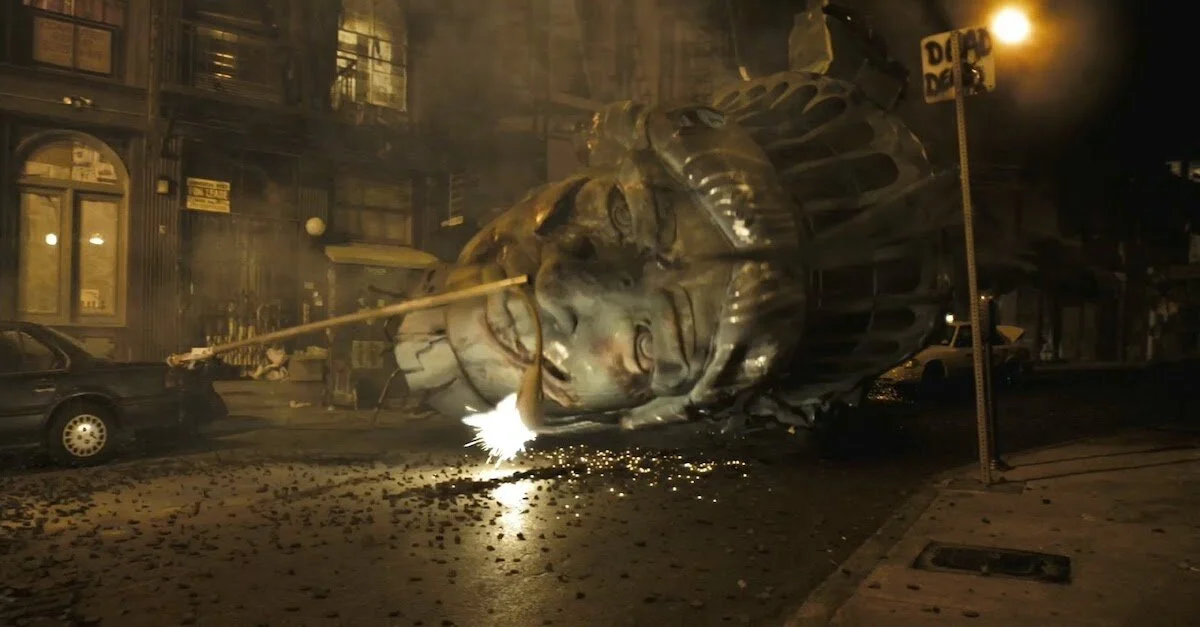Cloverfield (2008) – A Monster Movie Reinvented Through Found Footage Terror
Cloverfield, released in 2008, marked a radical shift in the monster movie genre by presenting a city-wide disaster not through sweeping cinematic shots, but through the unsteady, frantic lens of a handheld camera. Directed by Matt Reeves and produced by J.J. Abrams, the film uses the “found footage” format to drop viewers directly into the chaos, making the experience feel raw, immediate, and terrifyingly real. It’s not just a creature feature—it’s an exercise in immersive, first-person horror.
The story opens on what seems like a typical night in New York City. A farewell party is being held for Rob Hawkins (Michael Stahl-David), who is about to move to Japan for a new job. Friends gather, tensions simmer, and a subtle romantic subplot brews between Rob and Beth (Odette Yustman). But the party is suddenly interrupted by a massive explosion and what appears to be a violent, unexplained attack on the city. The camera, held by Rob’s friend Hud (T.J. Miller), captures everything as the group rushes outside to witness the decapitated head of the Statue of Liberty crashing into the street.
From there, the movie spirals into chaos. A colossal, unidentified creature is rampaging through Manhattan, toppling buildings and sending citizens into a desperate panic. The U.S. military launches a counterattack, but the beast proves nearly unstoppable. What makes Cloverfield so unique is its commitment to perspective: we only see what the characters see. The camera shakes, drops, and blacks out. There's no cut to news broadcasts, no outside context—just confusion, fear, and survival.
As Rob and a small group attempt to rescue Beth, who is trapped in her apartment building, they navigate through collapsing subways, deserted streets, and military barricades. Along the way, they’re stalked not just by the main monster but by smaller, parasitic creatures that fall from it and deliver lethal bites. These creatures add a second layer of danger and reinforce the unknown, terrifying biology of the threat.

The performances are naturalistic, aided by the film’s cinéma vérité style. T.J. Miller’s Hud provides occasional comic relief, but his off-screen commentary often reflects genuine fear. The lack of exposition heightens the realism: no one knows what’s happening, and that confusion mirrors what any real person might experience during a catastrophic event.
Visually, Cloverfield makes the most of its $25 million budget. Despite the found-footage format, the film features incredibly effective special effects, with glimpses of the towering creature, collapsed skyscrapers, and military carnage all rendered believably. Sound design plays a key role, with thunderous roars, explosions, and screams pulling the viewer deeper into the disaster.
Ultimately, Cloverfield is about helplessness in the face of the unknown. It taps into post-9/11 anxieties with its imagery of urban destruction and mass confusion, but it does so without ever naming the threat. The creature is never explained. There is no origin story. That deliberate mystery is what makes the film so haunting.
In conclusion, Cloverfield is a bold, innovative entry in the monster movie canon, blending found-footage realism with large-scale terror. Its commitment to perspective, tension, and authenticity makes it a standout in both horror and science fiction, and its legacy continues to influence genre films to this day.

-1751855090-q80.webp)
-1752031766-q80.webp)
